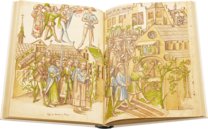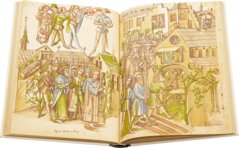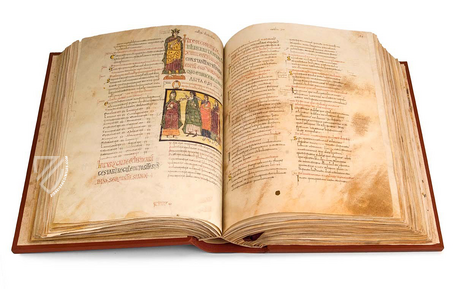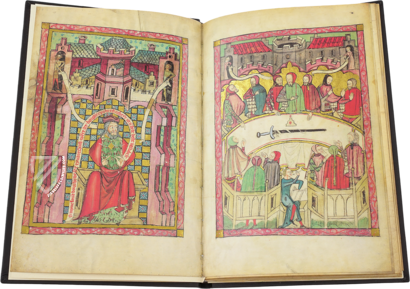Chronicle of the Council of Constance
(under 1,000€)
Held between 1414 and 1418, the Council of Constance was one of the most important ecumenical councils of the Middle Ages, which inter alia ended the Western Schism. Ulrich of Richtenthal, a citizen of Constance, chronicled this important series of meetings among the European clergy and nobility. However, while other sources focused on the theological debates and diplomatic negotiations, Richtenthal chronicles the festivities and ceremonies surrounding the Council as well as traffic in the city and other unofficial events. Written in the local Alemannic dialect of German, the text of this manuscript written on paper ca. 1465 is adorned by 98 masterful pen and ink drawings that resemble woodcuts, some of them full-pages, and 804 coats of arms.
Chronicle of the Council of Constance
Ulrich von Richenthal (died c. 1438) immortalized himself with his firsthand account of the Council of Constance (1414–18) and a large mural depicts him writing the work in the Oldtown of Constance today. While other accounts of this historic event exist, most are dry records written by clerics in Latin and none paints a picture as rich and as detailed as von Richenthal’s vernacular chronicle. The modern reader is transported to the scenic shores of Lake Constance in the early 15th century thanks to the detailed records and gorgeous illustrations of the work. As such, it is not merely a historical record but a slice of life from a prosperous late medieval city.
A Firsthand Account with Biases
The now-lost original manuscript appears to have been a collection of documents from the Council of Constance, illustrations, and von Richental’s own notes and observations. Its anti-clerical character and later association with the Reformation resulted in lasting interest in the work. There is a clear sympathy for Jan Hus (ca. 1372–1415) and reformers in general and a critical attitude toward the papal curia and its delegation. On the one hand, illustrations of Jan Hus are iconographically juxtaposed with those of the Passion of Christ, while on the other, the pope’s displays of splendor are contrasted with the gestures of humility made by King Sigismund (1368–1437). More attention is paid to secular events and imperial dignitaries than to ecclesiastical matters, which is evidenced by the number of coats of arms from the city’s burghers and nobleman and the relatively large number of secular addresses that are recorded.
A Wealth of Miniatures
The text of this historic work is adorned by 98 gorgeous pen and ink and 804 coats of arms. There is evidence of at least three and possibly even five hands participating in the rich illustration of this important text. The pen and ink drawings were mostly designed as double-page miniatures or form multi-page sequences of pictures, e.g. the pope’s entry into Constance (fol. 11r–12v) or the Corpus Christi procession (fol. 49v–53r). These illustrations are remarkable for their vivid realism and demonstrate a knowledge of early-15th century Dutch works of art through their dynamic movements, complex spatiality, detailed architectures, and differentiated gestures and physiognomies. It has been hypothesized that the master leading this team of artists was Konrad Witz (ca. 1400/10–1445/46), who was born in nearby Rottweil, is believed to have spent time in the Netherlands as a youth, and worked in Basel, which was upriver from Lake Constance. The rich illumination of the manuscript makes the events and personalities it describes come to life in a most artful manner, which greatly contributed to the lasting popularity of von Richental’s account of the Council of Constance.
Codicology
- Alternative Titles
- Ulrich Richental: Das Konzil zu Konstanz
Konzilchronik des Ulrich Richental
Chronicle of the Council of Constance by Ulrich Richental
Das Konzil zu Konstanz
Konzil von Konstanz
Das Konzil zu Konstanz MCDXIV-MCDXVIII
Chronik des Konzils zu Konstanz - Size / Format
- 300 pages / 39.0 × 29.0 cm
- Origin
- Germany
- Date
- Ca. 1465
- Epochs
- Style
- Language
- Script
- Littera bastarda
- Illustrations
- Pen drawings, coats of arms
- Artist / School
- Ulrich von Richental (ca. 1360–1437)
Chronicle of the Council of Constance
The Burning of Jan Hus
Aside from resolving the Western Schism, the Council of Constance is most famous for condemning the proto-Protestant religious leader Jan Hus as a heretic on July 6th, 1645. A secular court then sentenced him to be burned at the stake that same day despite the fact that he had been summoned under a letter of safe conduct. The fact that Hus wrote his will before departing for Constance indicates he may have known what was coming. Although he is depicted speaking or praying, which the record confirms, other details are missing e.g., Hus was undressed before his execution and was fastened to the stake by a chain around his neck.

Chronicle of the Council of Constance
The Enfeoffment of Frederick von Hohenzollern
Despite their association with Prussia, the House of Hohenzollern originated from Southern Germany before splitting into Swabian and Franconian branches. Burgrave Frederick VI of Nuremberg belonged to the latter branch and became the first member of his family to rule over the Margraviate of Brandenburg on the 30th of April 1415 when King Sigismund, depicted here making an announcement from a window, named him Margrave and Prince Elector of Brandenburg during the Council of Constance.
Frederick formally received the fiefdom on the 18th of April 1417 and began the transformation of the Hohenzollerns from a minor princely German family to one of Europe’s most powerful dynasties. Thus, the Council of Constance was the site of momentous events not only for the internal politics of the Church but for international relations among the lay princes of Europe.

#1 Das Konzil zu Konstanz
Language: German
(under 1,000€)
- Treatises / Secular Books
- Apocalypses / Beatus
- Astronomy / Astrology
- Bestiaries
- Bibles / Gospels
- Chronicles / History / Law
- Geography / Maps
- Saints' Lives
- Islam / Oriental
- Judaism / Hebrew
- Single Leaf Collections
- Leonardo da Vinci
- Literature / Poetry
- Liturgical Manuscripts
- Medicine / Botany / Alchemy
- Music
- Mythology / Prophecies
- Psalters
- Other Religious Books
- Games / Hunting
- Private Devotion Books
- Other Genres
- Afghanistan
- Armenia
- Austria
- Belgium
- Belize
- Bosnia and Herzegovina
- China
- Colombia
- Costa Rica
- Croatia
- Cyprus
- Czech Republic
- Denmark
- Egypt
- El Salvador
- Ethiopia
- France
- Germany
- Greece
- Guatemala
- Honduras
- Hungary
- India
- Iran
- Iraq
- Israel
- Italy
- Japan
- Jordan
- Kazakhstan
- Kyrgyzstan
- Lebanon
- Liechtenstein
- Luxembourg
- Mexico
- Morocco
- Netherlands
- Palestine
- Panama
- Peru
- Poland
- Portugal
- Romania
- Russia
- Serbia
- Spain
- Sri Lanka
- Sweden
- Switzerland
- Syria
- Tajikistan
- Turkey
- Turkmenistan
- Ukraine
- United Kingdom
- United States
- Uzbekistan
- Vatican City
- A. Oosthoek, van Holkema & Warendorf
- Aboca Museum
- Ajuntament de Valencia
- Akademie Verlag
- Akademische Druck- u. Verlagsanstalt (ADEVA)
- Aldo Ausilio Editore - Bottega d’Erasmo
- Alecto Historical Editions
- Alkuin Verlag
- Almqvist & Wiksell
- Amilcare Pizzi
- Andreas & Andreas Verlagsbuchhandlung
- Archa 90
- Archiv Verlag
- Archivi Edizioni
- Arnold Verlag
- ARS
- Ars Magna
- ArtCodex
- AyN Ediciones
- Azimuth Editions
- Badenia Verlag
- Bärenreiter-Verlag
- Belser Verlag
- Belser Verlag / WK Wertkontor
- Benziger Verlag
- Bernardinum Wydawnictwo
- BiblioGemma
- Biblioteca Apostolica Vaticana (Vaticanstadt, Vaticanstadt)
- Bibliotheca Palatina Faksimile Verlag
- Bibliotheca Rara
- Boydell & Brewer
- Bramante Edizioni
- Bredius Genootschap
- Brepols Publishers
- British Library
- C. Weckesser
- Caixa Catalunya
- Canesi
- CAPSA, Ars Scriptoria
- Caratzas Brothers, Publishers
- Carus Verlag
- Casamassima Libri
- Centrum Cartographie Verlag GmbH
- Chavane Verlag
- Christian Brandstätter Verlag
- Circulo Cientifico
- Club Bibliófilo Versol
- Club du Livre
- CM Editores
- Collegium Graphicum
- Collezione Apocrifa Da Vinci
- Comissão Nacional para as Comemorações dos Descobrimentos Portugueses
- Coron Verlag
- Corvina
- CTHS
- D. S. Brewer
- Damon
- De Agostini/UTET
- De Nederlandsche Boekhandel
- De Schutter
- Deuschle & Stemmle
- Deutscher Verlag für Kunstwissenschaft
- DIAMM
- Droz
- E. Schreiber Graphische Kunstanstalten
- Ediciones Boreal
- Ediciones Grial
- Ediclube
- Edições Inapa
- Edilan
- Editalia
- Edition Deuschle
- Edition Georg Popp
- Edition Leipzig
- Edition Libri Illustri
- Editiones Reales Sitios S. L.
- Éditions de l'Oiseau Lyre
- Editions Medicina Rara
- Editorial Casariego
- Editorial Mintzoa
- Editrice Antenore
- Editrice Velar
- Edizioni Edison
- Egeria, S.L.
- Eikon Editores
- Electa
- Emery Walker Limited
- Enciclopèdia Catalana
- Eos-Verlag
- Ephesus Publishing
- Ernst Battenberg
- Eugrammia Press
- Extraordinary Editions
- Fackelverlag
- Facsimila Art & Edition
- Facsimile Editions Ltd.
- Facsimilia Art & Edition Ebert KG
- Faksimile Verlag
- Feuermann Verlag
- Folger Shakespeare Library
- Franco Cosimo Panini Editore
- Friedrich Wittig Verlag
- Fundación Hullera Vasco-Leonesa
- G. Braziller
- Gabriele Mazzotta Editore
- Gebr. Mann Verlag
- Gesellschaft für graphische Industrie
- Getty Research Institute
- Giovanni Domenico de Rossi
- Giunti Editore
- Graffiti
- Grafica European Center of Fine Arts
- Guido Pressler
- Guillermo Blazquez
- Gustav Kiepenheuer
- H. N. Abrams
- Harrassowitz
- Harvard University Press
- Helikon
- Hendrickson Publishers
- Henning Oppermann
- Herder Verlag
- Hes & De Graaf Publishers
- Hoepli
- Holbein-Verlag
- Houghton Library
- Hugo Schmidt Verlag
- Idion Verlag
- Il Bulino, edizioni d'arte
- ILte
- Imago
- Insel Verlag
- Instituto de Estudios Altoaragoneses
- Instituto Nacional de Antropología e Historia
- Istituto dell'Enciclopedia Italiana - Treccani
- Istituto Ellenico di Studi Bizantini e Postbizantini
- Istituto Geografico De Agostini
- Istituto Poligrafico e Zecca dello Stato
- Italarte Art Establishments
- Jan Thorbecke Verlag
- Johnson Reprint Corporation
- Josef Stocker
- Josef Stocker-Schmid
- Jugoslavija
- Karl W. Hiersemann
- Kasper Straube
- Kaydeda Ediciones
- Kindler Verlag / Coron Verlag
- Kodansha International Ltd.
- Konrad Kölbl Verlag
- Kurt Wolff Verlag
- La Liberia dello Stato
- La Linea Editrice
- La Meta Editore
- Lambert Schneider
- Landeskreditbank Baden-Württemberg
- Leo S. Olschki
- Les Incunables
- Liber Artis
- Library of Congress
- Libreria Musicale Italiana
- Lichtdruck
- Lito Immagine Editore
- Lumen Artis
- Lund Humphries
- M. Moleiro Editor
- Maison des Sciences de l'homme et de la société de Poitiers
- Manuscriptum
- Martinus Nijhoff
- Maruzen-Yushodo Co. Ltd.
- MASA
- Massada Publishers
- McGraw-Hill
- Metropolitan Museum of Art
- Militos
- Millennium Liber
- Müller & Schindler
- Nahar - Stavit
- Nahar and Steimatzky
- National Library of Wales
- Neri Pozza
- Nova Charta
- Oceanum Verlag
- Odeon
- Orbis Mediaevalis
- Orbis Pictus
- Österreichische Staatsdruckerei
- Oxford University Press
- Pageant Books
- Parzellers Buchverlag
- Patrimonio Ediciones
- Pattloch Verlag
- PIAF
- Pieper Verlag
- Plon-Nourrit et cie
- Prestel Verlag
- Princeton University Press
- Prisma Verlag
- Priuli & Verlucca, editori
- Pro Sport Verlag
- Propyläen Verlag
- Pytheas Books
- Quaternio Verlag Luzern
- Reales Sitios
- Recht-Verlag
- Reichert Verlag
- Reichsdruckerei
- Reprint Verlag
- Riehn & Reusch
- Roberto Vattori Editore
- Rosenkilde and Bagger
- Roxburghe Club
- Salerno Editrice
- Saltellus Press
- Sandoz
- Sarajevo Svjetlost
- Schöck ArtPrint Kft.
- Schulsinger Brothers
- Scolar Press
- Scrinium
- Scripta Maneant
- Scriptorium
- Shazar
- Siloé, arte y bibliofilia
- SISMEL - Edizioni del Galluzzo
- Sociedad Mexicana de Antropología
- Société des Bibliophiles & Iconophiles de Belgique
- Soncin Publishing
- Sorli Ediciones
- Stainer and Bell
- Studer
- Styria Verlag
- Sumptibus Pragopress
- Szegedi Tudomànyegyetem
- Taberna Libraria
- Tarshish Books
- Taschen
- Tempus Libri
- Testimonio Compañía Editorial
- Thames and Hudson
- The Clear Vue Publishing Partnership Limited
- The Facsimile Codex
- The Folio Society
- The Marquess of Normanby
- The Richard III and Yorkist History Trust
- Tip.Le.Co
- TouchArt
- TREC Publishing House
- TRI Publishing Co.
- Trident Editore
- Typis Regiae Officinae Polygraphicae
- Union Verlag Berlin
- Universidad de Granada
- University of California Press
- University of Chicago Press
- Urs Graf
- Vallecchi
- Van Wijnen
- VCH, Acta Humaniora
- VDI Verlag
- VEB Deutscher Verlag für Musik
- Verlag Anton Pustet / Andreas Verlag
- Verlag Bibliophile Drucke Josef Stocker
- Verlag der Münchner Drucke
- Verlag für Regionalgeschichte
- Verlag Styria
- Vicent Garcia Editores
- W. Turnowski Ltd.
- W. Turnowsky
- Waanders Printers
- Wiener Mechitharisten-Congregation (Wien, Österreich)
- Wissenschaftliche Buchgesellschaft
- Wissenschaftliche Verlagsgesellschaft
- Wydawnictwo Dolnoslaskie
- Xuntanza Editorial
- Zakład Narodowy
- Zollikofer AG





























































